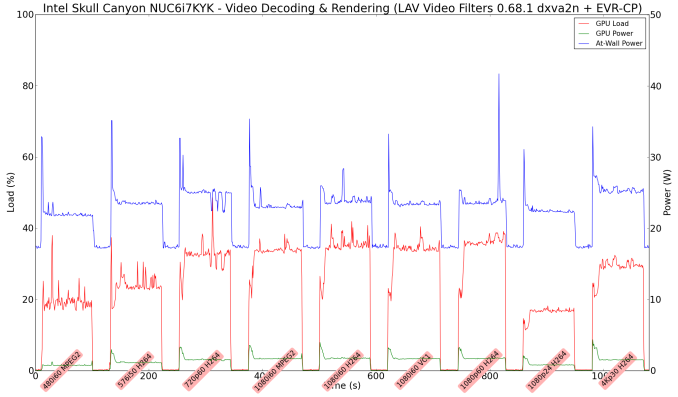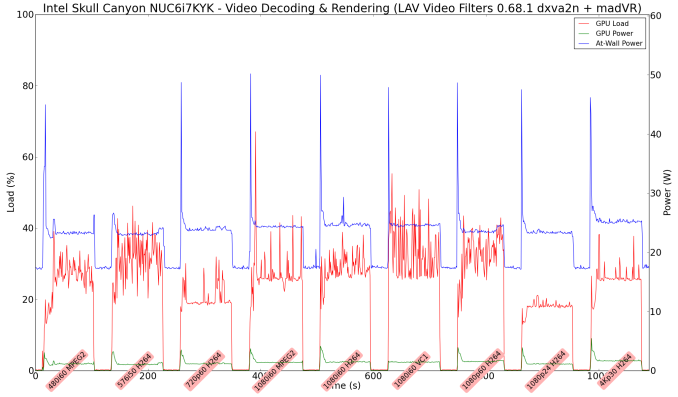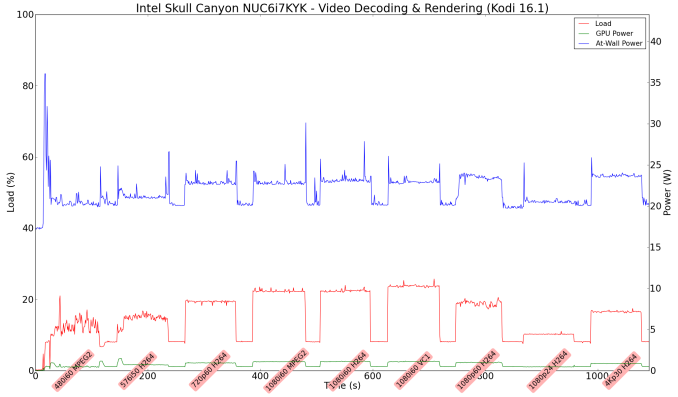The Intel Skull Canyon NUC6i7KYK mini-PC Review
by Ganesh T S on May 23, 2016 8:00 AM ESTHTPC Credentials
The higher TDP of the processor in Skull Canyon, combined with the new chassis design, makes the unit end up with a bit more noise compared to the traditional NUCs. It would be tempting to say that the extra EUs in the Iris Pro Graphics 580, combined with the eDRAM, would make GPU-intensive renderers such as madVR operate more effectively. That could be a bit true in part (though, madVR now has a DXVA2 option for certain scaling operations), but, the GPU still doesn't have full HEVC 10b decoding, or stable drivers for HEVC decoding on WIndows 10. In any case, it is still worthwhile to evaluate basic HTPC capabilities of the Skull Canyon NUC6i7KYK.
Refresh Rate Accurancy
Starting with Haswell, Intel, AMD and NVIDIA have been on par with respect to display refresh rate accuracy. The most important refresh rate for videophiles is obviously 23.976 Hz (the 23 Hz setting). As expected, the Intel NUC6i7KYK (Skull Canyon) has no trouble with refreshing the display appropriately in this setting.
The gallery below presents some of the other refresh rates that we tested out. The first statistic in madVR's OSD indicates the display refresh rate.
Network Streaming Efficiency
Evaluation of OTT playback efficiency was done by playing back our standard YouTube test stream and five minutes from our standard Netflix test title. Using HTML5, the YouTube stream plays back a 1080p H.264 encoding. Since YouTube now defaults to HTML5 for video playback, we have stopped evaluating Adobe Flash acceleration. Note that only NVIDIA exposes GPU and VPU loads separately. Both Intel and AMD bundle the decoder load along with the GPU load. The following two graphs show the power consumption at the wall for playback of the HTML5 stream in Mozilla Firefox (v 46.0.1).

GPU load was around 13.71% for the YouTube HTML5 stream and 0.02% for the steady state 6 Mbps Netflix streaming case. The power consumption of the GPU block was reported to be 0.71W for the YouTube HTML5 stream and 0.13W for Netflix.
Netflix streaming evaluation was done using the Windows 10 Netflix app. Manual stream selection is available (Ctrl-Alt-Shift-S) and debug information / statistics can also be viewed (Ctrl-Alt-Shift-D). Statistics collected for the YouTube streaming experiment were also collected here.

Decoding and Rendering Benchmarks
In order to evaluate local file playback, we concentrate on EVR-CP, madVR and Kodi. We already know that EVR works quite well even with the Intel IGP for our test streams. Under madVR, we used the DXVA2 scaling logic (as Intel's fixed-function scaling logic triggered via DXVA2 APIs is known to be quite effective). We used MPC-HC 1.7.10 x86 with LAV Filters 0.68.1 set as preferred in the options. In the second part, we used madVR 0.90.19.
In our earlier reviews, we focused on presenting the GPU loading and power consumption at the wall in a table (with problematic streams in bold). Starting with the Broadwell NUC review, we decided to represent the GPU load and power consumption in a graph with dual Y-axes. Nine different test streams of 90 seconds each were played back with a gap of 30 seconds between each of them. The characteristics of each stream are annotated at the bottom of the graph. Note that the GPU usage is graphed in red and needs to be considered against the left axis, while the at-wall power consumption is graphed in green and needs to be considered against the right axis.
Frame drops are evident whenever the GPU load consistently stays above the 85 - 90% mark. We did not hit that case with any of our test streams. Note that we have not moved to 4K officially for our HTPC evaluation. We did check out that HEVC 8b decoding works well (even 4Kp60 had no issues), but HEVC 10b hybrid decoding was a bit of a mess - some clips worked OK with heavy CPU usage, while other clips tended to result in a black screen (those clips didn't have any issues with playback using a GTX 1080).
Moving on to the codec support, the Intel Iris Pro Graphics 580 is a known quantity with respect to the scope of supported hardware accelerated codecs. DXVA Checker serves as a confirmation for the features available in driver version 15.40.23.4444.
It must be remembered that the HEVC_VLD_Main10 DXVA profile noted above utilizes hybrid decoding with both CPU and GPU resources getting taxed.
On a generic note, while playing back 4K videos on a 1080p display, I noted that madVR with DXVA2 scaling was more power-efficient compared to using the EVR-CP renderer that MPC-HC uses by default.




















133 Comments
View All Comments
JohnGalt1717 - Monday, May 23, 2016 - link
Can someone tell me if they have been able to run 4x 4K monitors (i.e. HDMI hooked to one, mDp hooked to another and then 2 mDp hooked via adapter to the Thunderbolt 3 port)?Looking to replace my desktop but need 4 screens.
DanNeely - Monday, May 23, 2016 - link
Unfortunately while you'd have the connectivity to do so, I think Intel's IGP itself is still capped at 3 displays.BurntMyBacon - Tuesday, May 24, 2016 - link
@JohnGalt1717: "Can someone tell me if they have been able to run 4x 4K monitors ..."I just tried it with a slightly different setup, but it was still an HQ processor with Iris Pro 580 (i7-6870HQ). It looks like DanNeely is correct. The IGP is still capped at 3 displays even without considering 4K.
JohnGalt1717 - Wednesday, May 25, 2016 - link
too Bad :<xchaotic - Monday, May 23, 2016 - link
What is the expected market for this? For both my professional and personal uses, lack of proper dGPU support is a deal breaker - for anything from games, through movie and photo enhancements to machine learning and graph stores all being accelerated by DGPUs, I suspect this will have a very limited to a very small subset of hardcore enthusiastblahsaysblah - Monday, May 23, 2016 - link
I had the NUC5i7, the machine was just too loud when used in professional manner. And it was ridiculous, they had space to put a better cooler.I had my doubts when initial mockups flew around internet. This is again another useless NUC. Crazy who has final say over design on this at Intel. They just keep shooting themselves in the foot. Seriously. They are afraid of success.
JoeyJoJo123 - Monday, May 23, 2016 - link
Not every game requires a dGPU, as many popular MOBAs play just fine without it, and there are people who play competitively for these games on worse hardware.This is nice as a HTPC, a thin-client, an emulation station, or a monitor/TV mounted PC for grandma or grandpa.
Understandably, this isn't a product you need, but do keep in mind that others on the market do want mini-PCs and can find a use for them.
JoeyJoJo123 - Monday, May 23, 2016 - link
Oh, also, the inclusion of Thunderbolt 3 means this could be a PC you can velcro to a external graphics card dock (like the Razer Core) to have a very portable LAN PC.LostWander - Monday, May 23, 2016 - link
It's mentioned in the article that the external graphics dock likely won't work because the thunderbolt port isn't given enough bandwidthLostWander - Monday, May 23, 2016 - link
won't work well*The link is only at a maximum PCIe 3.0 x4 under ideal conditions and it is separated from the CPU so the performance gain won't be optimal.